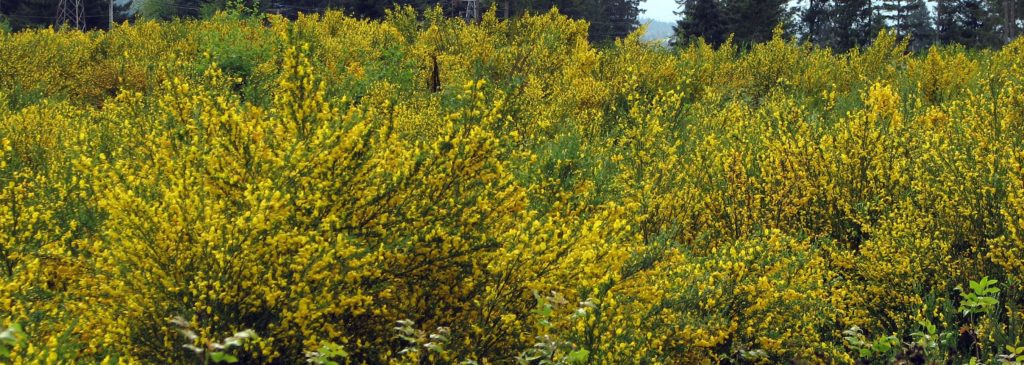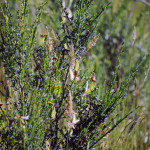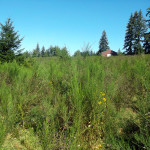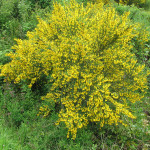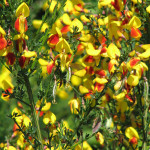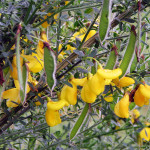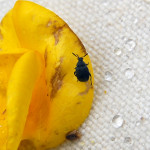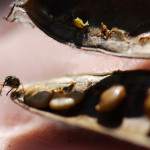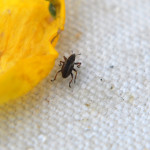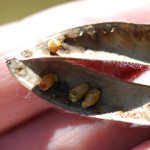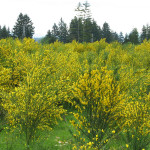Common name:
Scotch broom, Scot’s broom, English broom
Scientific Name:
Cytisus scoparius (syns. Sarothamnus scoparius, Spartium scoparium)
Noxious Weed Listing:
- WeedWise: Maintenance
- State of Oregon: Class B
- State of Washington: Class B
- Four County CWMA: Class B
- Columbia Gorge CWMA: Class B
Description:
General:
Scotch broom is a fast growing shrub in the Fabaceae (pea) family, characterized by its masses of yellow flowers. It grows upright on young, green, 5-angled stems which are hairy. Broom forms dense stands and is shade intolerant. Mature plants can reach 10 feet in height although most plants are typically 3-5 feet tall. Scotch broom is a deciduous nitrogen-fixing plant. Scotch broom is an invasive plant found in low elevations from British Columbia to California.
Leaves:
The leaves of Scotch broom are alternate and compound consisting of three oblong leaflets. Very few leaves on stems. New twigs may only have one leaflet. Leaflets are small 5-20 mm long. The leaflets are dark green and fleshy and serrated along their margin. The underside of the leaflets are covered by flattened, short hairs while the upper surface is smooth.
Flowers
The flowers are pea-like; upper and lower curved petal have wing petals on each side. Scotch broom flowers are yellow to partially to complete red in color. Small, only 1-2.5 cm. The stamens are fused. Plants flower from April to June.
Fruits
Fruits develop as seed pods that mature in June-July. Seed pods are flat, 2-5 cm long, smooth with long silky hairs which turn dark brown to black when mature. Seeds are small 2mm, long and shiny, brown to black in color with a whitish appendage (fatty deposit) which attracts ants and some birds. 3-12 seeds found within each pod.
Roots
The Scotch broom plants form deep, branched taproots with fine roots associated with nitrogen fixation. New shoots can grow from the crown when plants are cut above the crown.
Reproduction:
Scotch broom reproduces by seed. Seeds are dispersed when pods dry, split in half and twist. This action can send seeds up to 3 meters but is often just a short distance from the plant. A variety of ants are attracted to the white seed appendages and disperse the seeds further. Seeds have a hard coating which allows them to survive up to 30 years in the field. Scotch broom produces seed at 2 or 3 years but is in full reproduction at 3-5 years lasting until year 9. Up to 3500 pods can be produced from one adult shrub. Scotch broom lives for 15-20 years.
Habitat:
The areas most infested by Scotch broom are disturbed sites, grasslands, open forests, and riparian corridors. The plant likes coastal areas and low elevations in dry conditions with plenty of sunshine. Scotch broom flourishes in infertile soil because it is a nitrogen-fixing plant which allows it to grow where many plants fail to flourish. Scotch broom likes sandy, acidic and dry soil.
Impacts:
- Grows rapidly and forms dense stands.
- Out-competes native plants by shading out and by changing soil fertility.
- Prevents reforestation by out-competing conifer seedlings.
- Dramatically increases the hazard and intensity of fires
- Displaces native plants and wildlife.
Introduction:
The original introduction of Scotch broom to Oregon is believed to have occurred between 1875 and 1899 (Christy et al., 2009). The plant is native to Europe and North Africa and was commonly introduced by European settlers to remind them of their home but quickly escaped cultivation. It was also used to stabilize soil, especially along roadways before the realization of its invasive characteristics. Due to its showy flowers, Scotch broom was commonly produced in the horticultural trade where many varieties have been developed.
Distribution:
Clackamas County:
Scotch broom can be found throughout Clackamas County. It is very widespread and directly impacts properties throughout the county. As a ubiquitous weed, this is not a species that is actively surveyed and the mapped distributions do not represent the full extent of the Scotch broom population in Clackamas County.
State of Oregon:
United States:
Management:
Strategy:
The management of invasive weeds is best served through a process known as Integrated Pest Management (IPM). IPM is a weed management methodology that utilizes:
- Management thresholds to determine when and if to initiate control,
- The ecology and life history characteristics of the targeted invasive weed,
- Site-specific conditions and land use considerations to inform management practices,
- The effectiveness and efficiency of various control methods.
An IPM based strategy ensures the maximum effectiveness of treatment measures. IPM strategies typically use more than one management method to target one or more susceptible life stages. It is adaptive to site conditions in the field and to the response of a plant to management. The utilization of multiple management tools also inherently reduces the use of herbicides in a management plan. The IPM process ultimately provides a framework for the establishment of Best Management Practices (BMP) which outlines the best approach for controlling a weed particular infestation.
Manual:
The control of Scotch broom can be a difficult task. The long-lived seeds, long growing season, aggressive roots, thick stands and the ability to resprout from young stumps or root crowns make Scotch broom difficult to control.
Manual removal of Scotch broom can be an effective control option especially for smaller infestations, but it is labor intensive. Seedling and small shrubs can be hand pulled between January and May. Pulling when the soil is moist will make it easier to remove the roots and put less strain on the worker. All plants and roots need to be removed to reduce regrowth. Continual manual removal, every year pulling the next generation, is one of the most effective controls for Scotch broom. A weed wrench, shovel or hoe can be used to assist with root removal.
While manual removal can be an effective treatment, it can cause heavy soil disturbances on site. Soil disturbance can bring broom seeds deep in the soil to the surface creating a new generation of growth.
For old established stands, cut Scotch broom between ground level and three inches using loppers or a saw during the dry season (July to August). Try to cut before seed pods mature to limit spread.
Cutting alone during the right time can be a useful management tool to prevent seeding. Young Scotch broom plants will resprout following cutting from above the root crowns. Older plants generally will not resprout following a cutting. Large stands of resprouting plants following cutting are best controlled with a targeted herbicide application.
Mechanical:
Large infestations of Scotch broom can be removed through mowing. Like cutting, brush mowing alone won’t kill the broom. Mowing should be done between flowering and seed maturity and must be repeated at regular intervals to exhaust plant. Mowing is not a very effective control by itself, however, when used in conjunction with herbicide application it can be very effective.
Mowing equipment can transport seeds if not cleaned before leaving a site and if plants are cut during seed production.
Cultural:
Burning can be an effective tool to remove debris, but it will not eliminate Scotch broom. Other management such as crown removal or herbicide application is required to achieve control. The available fuels in dense broom stands can also be substantial, so care needs to be taken to keep a fire contained. As such fire is generally not a recommended control measure. You should check with your local Fire District or the Oregon Department of Forestry for rules and recommendations.
Grazing by goats is a potential method for controlling Scotch broom. Unfortunately, broom plants can be toxic to both humans and livestock which limits other grazing activity. Goats confined to a small area will eat the resprouting Scotch broom after treatment.
Chemical:
Chemical control is an effective tool to control large stands of Scotch broom. Continued treatment and monitoring will be required due to the copious number of seedlings emerging from the seed bank. Scotch broom is susceptible to several systemic herbicides. Plants should not be mowed or cut after application for a minimum of two weeks to allow the herbicide to reach the roots. Scotch broom flowers can hinder herbicide application by not allowing the chemical to reach other areas of the plant. Large treated/dead stands of brooms are a fire hazard and need to be monitored and removed if necessary.
Before you Start:
- Before purchasing any herbicide product it is important to read the label. The label is the Law. Carefully review all parts of the label even if you have used the product before. Select a product that is most appropriate for your site. If you have questions, ask your vendor before purchasing a product.
- When selecting herbicides always use a product appropriately labeled for your site. Follow label recommendations and restrictions at all times. If any information provided here contradicts the label, the label takes precedence. Always follow the label!
- Protect yourself. Always wear the recommended protective clothing identified on your label and shower after use.
- When applying herbicides use spot spray techniques whenever possible to avoid harming non-target plants.
- Do not apply during windy or breezy conditions that may result in drift to non-target plants
- Avoid spraying near water. Hand-pull in these areas, to protect aquatic and riparian plants and wildlife.
- Avoid exposure to pets, pollinators, and wildlife. Remove animals from treatment areas to avoid exposure to herbicides. Follow the reentry instructions on your herbicide label and keep pets out of the area until the herbicides have dried. Avoid spraying when insects and animals are active. Avoid spraying blooming plants to minimize any effects to bees and pollinators.
- Be sure to store any chemicals, out of the reach of children and pets to keep your family safe.
- Product labels and formulations change regularly. Check the Pacific Northwest Weed Management Handbook and the label for current control recommendations.
Herbicides:
The mention of any brand name product is not, and should not be construed as an endorsement for that product. They are included here only for educational purposes. Suggested rates are generalized by active ingredient. Specific rates will vary between products. Be sure to review the label before application and use the recommended label rate at all times.
Active Ingredients
Product Names: Accord, Aquamaster, Rodeo, Roundup, XRT II, and various others
Rate:
Spot treat: use 1.5% to 2% v/v solutions.
Cut stump: 25% v/v (up to 50% can reduce resprouting)
Time: Foliar application in late summer or early fall. Cut stump application again in late summer to early fall, immediately after cutting.
Comments: Re-treatment may be required to achieve effective control. Glyphosate is not selective and will harm grasses. Use care when working around desirable plants to avoid damage. Leaves should be sprayed until wet but not dripping to achieve good control. Cut stems horizontally at or near ground level and immediately apply herbicide.
Product Names: Garlon 4 (triclopyr ester), Garlon 3A, Element 3A (triclopyr amine), Pathfinder II
Rate:
Broadcast: Triclopyr ester- 2 – 3 qts/acre (1 – 1.5 at ae/acre), Triclopyr amine- 3 – 4 qts/acre (1.125 – 1.5 qt ae/acre)
Spot treat: Triclopyr ester use 0.75% to 1% v/v solution, Triclopyr amine use 1% – 1.5% v/v solution plus 0.25% – 0.5% v/v surfactant
Basal Bark: Triclopyr ester- use 20% v/v solution ethylated crop oil and water
Cut stump: Triclopyr amine-50% in water
Time: Apply post emergence when plants are growing rapidly in the spring and again in the fall. Applications should be made before a killing frost.
Comments: Re-treatment may be required to achieve effective control. Triclopyr is selective and will not harm grasses but will harm desirable broadleaf plants, trees, and shrubs. Use care when working around desirable plants to avoid damage. Leaves should be sprayed until wet but not dripping to achieve good control. Triclopyr ester formulations may volatilize under warm temperatures.
Product Names: Crossbow (Triclopyr + 2, 4D)
Rate:
Spot treat: 0.5% to 1.5% v/v solution
Time: Apply post emergence when plants are growing rapidly in the spring and again in the fall. Applications should be made before a killing frost.
Comments: Re-treatment may be required to achieve effective control. Triclopyr + 2, 4D is selective and will not harm grasses, but may damage desirable broadleaf plants, trees, and shrubs. Use care when working around desirable plants to avoid damage. Leaves should be sprayed until wet but not dripping to achieve good control. Check the label for specific warnings and recommendations.
Product Names: Arsenal, Habitat, Stalker, Chopper, Polaris
Rate:
Spot treat: 1 to 2% v/v solution plus 0.25 to 0.5% surfactant v/v
Cut stump: 20% v/v solution in water plus 20% ethylated crop oil
Basal bark: 20% v/v solution in water plus 20% ethylated crop oil
Time: Apply post emergence in late summer to early fall when the plant is growing rapidly. Best when used in late summer to early fall.
Comments: Imazapyr is a soil residual herbicide and may result in bare ground around plants after treatment.
Product Names: Tordon 22K
Rate:
Broadcast: 2 pints/acre (non-cropland) or 1 qt/acre (rangeland) plus 0.25 to 0.5% v/v surfactant
Time: Apply post emergence in spring and again in fall when plants are growing rapidly at or beyond early to full bloom stage.
Comments: Picloram can cause long-term soil activity and should not be used around trees because of root uptake. Use care when working around desirable plants to avoid damage. Leaves should be sprayed until wet but not dripping to achieve good control. Restricted herbicide: not registered in California.
Biological:
There are several insects which feed on the seeds and leaves of Scotch broom. Scotch broom bruchid (Bruchidius villosus), Scotch broom seed weevils (Exapion fuscirostre or Aprion fuscirostre), twig mining moth (Leucoptera sartifolilella), Eriophyid gall mite (Aceria genistae) and the shoot tip leaf moth (Agonopterix nervosa) are known to damage the Scotch broom plants. These bugs will not eradicate an infestation, they have poor to fair effectiveness controlling a stand and any results might not be seen for up to 7 years.
Disposal:
Scotch broom plants that have not gone to seed are able to be disposed of in regular household trash cans or in yard debris containers. Cut plants can be left on site but can be a fire hazard. Scotch broom plants that have gone to seed should be left on site to minimize the spread of the seeds, or piled on tarps and bagged before being moved off-site. Plant debris can also be burned on site with appropriate safety measures and permits. You should check with your local Fire District or the Oregon Department of Forestry for rules and recommendations.
Follow-Up:
Diligence is the most important aspect for controlling Scotch broom. New broom plants will germinate from the seed bank living in the soil even after years following treatments and soil disturbances, so repeated follow-up is required.
Best Management Practices:
Small Infestations:
- Consider the land use practices on site. Identify, any site-specific considerations that should be taken into account before initiating control.
- Be sure you can properly identify Scotch broom. If you are unsure about your weed bring a sample to the Conservation District, and we can help to identify your particular weed.
- Identify any native or desirable plants nearby, and take precautions to minimize any negative impact on them.
- Manual removal is very effective at controlling small infestations of Scotch broom (plants under 1″). Plants can be pulled or dug up when the soil is moist (fall through spring).
- Replace divots and holes created.
- Spot spray herbicide appropriately.
- Monitor the site for regrowth, and remove new sprouts as soon as they appear.
- Do not leave soil bare, mulch or replant to stabilize soil and compete with broom regrowth.
- Replant heavily infested areas to increase shade and suppress new seedlings.
Large Infestations:
- Consider the land use practices on site. Identify, any site-specific considerations that should be taken into account before initiating control.
- Be sure you can properly identify Scotch broom. If you are unsure about your weed bring a sample to the Conservation District, and we can help to identify your particular weed.
- Identify any native or desirable plants nearby, and take precautions to minimize any negative impact on them.
- Mow or cut down the Scotch broom using a brush mower or chainsaw to remove large well-established individuals.
- Apply herbicides to cut stems to prevent regrowth.
- Follow up with a broadcast or spot herbicide application to treat seedlings and resprouting plants.
- Several applications over several years will be needed to suppress and eradicate Scotch broom infestations.
- Continue to monitor the site for regrowth and treat any new infestations.
- Replant heavily infested areas to increase shade and suppress new seedlings.
Fun Facts:
- Scotch broom gets its name because the plant is historically used in Scotland to make brooms.
- Photosynthesis occurs in the green stems and not in the leaves (like most plants).
- Used to make cloth, coffee and as a diuretic.
- Scotch broom contains chemicals (toxic alkaloids sparteine and isosparteine) that affects heart rhythm and one that might increase body water loss. (Unsafe to use medicinally)
Gallery:
- Vegetative Scotch broom
- large vegetated Scotch Broom Infestation
- Scotch broom plant
- Scotch broom flowers
- Scotch broom bicolor flower
- Scotch broom flowers and seed pods
- Scotch broom seed pod
- Scotch broom bruchid (Bruchidius villiosus) biological control
- Scotch broom seed weevil biological control emerging from seed pod
- Scotch broom seed weevil (Exapion fuscirostre) biological control
- Scotch broom bruchid (Bruchidius villosus) biological control damage to seed
- Scotch broom infestation
Additional Information:
- Oregon Department of Agriculture: Scotch broom
- Washington State Noxious Weed Control Board; Scotch broom
- Oregon State University Extension: Invasive Weeds in Forest Land Brooms
- Invasive.org: GIST Elemental Stewardship Abstract
- Pacific Northwest Weed Management Handbook: Scotch broom
- King County Washington: Scotch broom Best Management Practices
- Center for Invasive Species and Ecosystem Health
- CABI Global Invasive Species Compendium
References:
- Bossard, C. C., J. M. Randall, & M.C. Hoshovsky. 2000. Invasive Plants of California’s Wildlands. Berkeley, CA: University of California Press. pp 277-281.
- Christy, J. A., A. Kimpo, V. Marttala, P. K. Gaddis, & N. L. Christy. 2009. Urbanizing Flora of Portland Oregon 1806-2008. Native Plant Society of Oregon Occasional Paper 3 pg. 218.
- DiTomaso, J.M. & E.A. Healy. 2007. Weeds of California and Other Western State vol 2. University of California ANR. pp 1426-1434.
- DiTomaso, J.M., G.B. Kyser, S.R. Oneto, R. G. Wilson, S. B. Orloff, L. W. Anderson, S. D. Wright, J.A. Roncoroni, T.L. Miller, T.S. Prather. 2013. Weed Control in Natural Areas in the Western United States. Davis, CA: UC Weed Research and Information Center. pp 341-343.
- Holloran, P., A. Mackenzie, S Farrell, D. Johnson. 2004. The Weed Workers Handbook: A Guide to Techniques for Removing Bay Area Invasive Plants. Berkeley, CA: California Invasive Plant Council. pp 60-61
- Kaufman, S. R. & W. Kaufman. 2007. Invasive Plants: Guide to identification and the Impacts and Control of Common North American Species. Mechanicsburg, PA: Stackpole Books. pp 145-151
- King County Noxious Weed Control Program. 2011. King County Best Management Practices for Controlling Scotch Broom, Scot’s Broom (Cytisus scoparius). https://your.kingcounty.gov/dnrp/library/water-and-land/weeds/BMPs/Scotch-Broom-Control.pdf (Retrieved Feb 25, 2016).
- Oregon Flora Project. 2013. Oregon Plant Atlas: Scotch broom. https://www.oregonflora.org/atlas.php. (Retrieved Feb 25, 2016)
- Peachy, E., D. Ball, A. Hulting, T. Miller, D. Morishita, P. Hutchinson. eds. 2013. Pacific Northwest Weed Management Handbook: Control of Problem Weeds. (Retrieved Feb 25, 2016).
- Hoshovsky, M. 2001. Element Stewardship Abstract for Cytisus scoparius and Genista monspessulanus Scotch Broom, French Broom. The Nature Conservancy. https://www.invasive.org/weedcd/pdfs/tncweeds/cytisco.pdf (Retrieved Feb 25, 2016)

